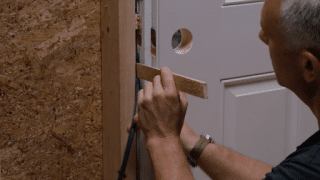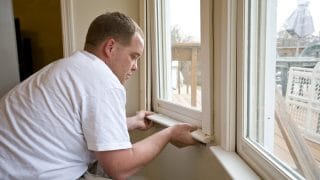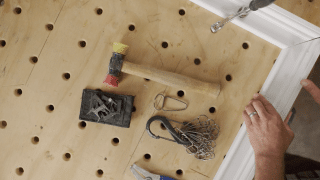
When building or updating a home, it’s important to focus on the fundamentals that keep your home exterior shielded from damage. One of those key elements is fascia board. Here’s how fascia can both beautify and protect a home.
What is fascia on a house?
The word fascia is Latin for “band” or “bandage,” and both meanings are relevant to fascia board in the context of its purpose as a building material. Roof fascia is the most common type of fascia on a house. It is a short vertical board that covers the roof rafters, installed at the roofline where the edge of the roof and walls meet.
This type of fascia board doesn’t just boost curb appeal. It also provides important protection and function like:
- Protection from weather and pests. One of fascia’s chief jobs is acting as a line of defense, preventing moisture from leaking into the roof and causing water damage. It also stops birds, squirrels, insects, and other pests from entering the attic. Installing a drip edge can help preserve your fascia work by routing water away from the edge.
- Supports roofing. Fascia is also responsible for supporting crucial roofing materials. It secures the gutters and drain pipes to the home, allowing the guttering system to send water away. Roof fascia may support the bottom row of the roof’s tiles or slates as well.
Another type of fascia is found in deck projects. As with a roof, the fascia board on a deck is installed just below the surface line and spans the perimeter. Deck fascia covers joists and other structures of the deck’s frame for a seamless look that hides rough edges.
Soffit vs. fascia
When discussing roofs, you’ll often hear soffit and fascia mentioned together. Soffit is siding or other material installed to cover the space where part of the roof hangs over the exterior wall. It can be vented to help circulate air through the attic. Together soffit and fascia hide unsightly parts of the home and shield it from the elements.
Which fascia board material is right for your project?
There are several types of fascia materials, including wood, vinyl, and aluminum.
Wood fascia
Wood has been the traditional choice for fascia, with builders simply repurposing materials used for the roofing deck. It’s a convenient and inexpensive option. But homeowners will have to replace or repair wood boards more often, as they aren’t waterproof without special coatings that need upkeep.
You’ll also have to check wood fascia periodically for wood rot, mold, warping, and insects, and keep painting and fixing them to avoid damage. You may find the time it takes to repair the boards or do a full fascia replacement isn’t worth the cost savings.
Vinyl fascia
Made of polyvinyl chloride (PVC), vinyl fascia is another inexpensive choice, but one that’s much more durable than wood. It can be installed right over wood fascia to improve durability. It’s also resistant to water, rot, mold, rust, and insect damage, so you won’t need to worry much about maintenance.
When building or updating a home, it’s important to focus on the fundamentals that keep your home exterior shielded from damage. One of those key elements is fascia board. Here’s how fascia can both beautify and protect a home.
What is fascia on a house?
The word fascia is Latin for “band” or “bandage,” and both meanings are relevant to fascia board in the context of its purpose as a building material. Roof fascia is the most common type of fascia on a house. It is a short vertical board that covers the roof rafters, installed at the roofline where the edge of the roof and walls meet.
This type of fascia board doesn’t just boost curb appeal. It also provides important protection and function like:
- Protection from weather and pests. One of fascia’s chief jobs is acting as a line of defense, preventing moisture from leaking into the roof and causing water damage. It also stops birds, squirrels, insects, and other pests from entering the attic. Installing a drip edge can help preserve your fascia work by routing water away from the edge.
- Supports roofing. Fascia is also responsible for supporting crucial roofing materials. It secures the gutters and drain pipes to the home, allowing the guttering system to send water away. Roof fascia may support the bottom row of the roof’s tiles or slates as well.
Another type of fascia is found in deck projects. As with a roof, the fascia board on a deck is installed just below the surface line and spans the perimeter. Deck fascia covers joists and other structures of the deck’s frame for a seamless look that hides rough edges.
Soffit vs. fascia
When discussing roofs, you’ll often hear soffit and fascia mentioned together. Soffit is siding or other material installed to cover the space where part of the roof hangs over the exterior wall. It can be vented to help circulate air through the attic. Together soffit and fascia hide unsightly parts of the home and shield it from the elements.
Which fascia board material is right for your project?
There are several types of fascia materials, including wood, vinyl, and aluminum.
Wood fascia
Wood has been the traditional choice for fascia, with builders simply repurposing materials used for the roofing deck. It’s a convenient and inexpensive option. But homeowners will have to replace or repair wood boards more often, as they aren’t waterproof without special coatings that need upkeep.
You’ll also have to check wood fascia periodically for wood rot, mold, warping, and insects, and keep painting and fixing them to avoid damage. You may find the time it takes to repair the boards or do a full fascia replacement isn’t worth the cost savings.
Vinyl fascia
Made of polyvinyl chloride (PVC), vinyl fascia is another inexpensive choice, but one that’s much more durable than wood. It can be installed right over wood fascia to improve durability. It’s also resistant to water, rot, mold, rust, and insect damage, so you won’t need to worry much about maintenance.
Vinyl isn’t subject to the water-fueled warping that can happen with wood but it can still expand and shrink because of temperature changes. And it’s crucial that its seal to the house remains tight.
Aluminum fascia
Aluminum, too, can be installed either by itself or with wood fascia, as it’s easy to mold and bend. But installation of this durable material usually requires a professional, and it can be expensive.
Composite fascia
True to its name, composite is composed of multiple materials: recycled wood chips, sawdust, and/or plastic, bonded using epoxy resin. It holds up and protects well, and its color stays true over time. Composite isn’t as widely used, as it can be more expensive and has fewer color options.
MT Copeland offers video-based online classes that give you a foundation in construction fundamentals with real-world applications, like how to build a freestanding deck.
Classes include professionally produced videos taught by practicing craftspeople, and supplementary downloads like quizzes, blueprints, and other materials to help you master the skills.







